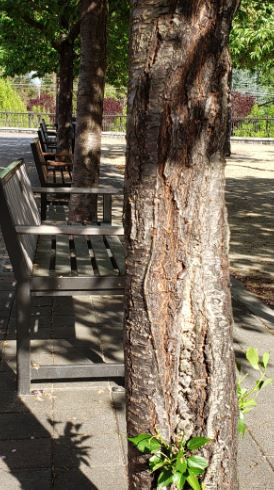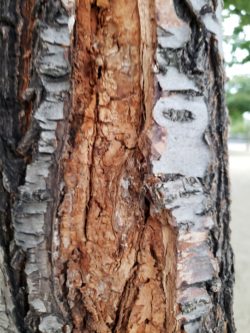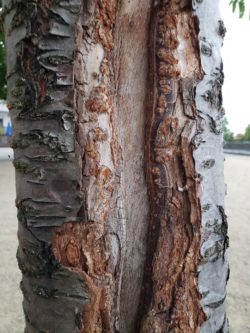
Tree Sunburn
The sunny, clear days of Oregon summers send us scampering for shade to protect our delicate skin from dangerous UV rays. Trees can be damaged by the sun too. The mature cherry tree seen above has a sealed sunburn wound.
When the amount of direct sunlight the tree receives abruptly increases, the extra heat and radiation can damage the nutrient-exchanging tissues beneath the bark. Often the first sign of the damage is bark discoloration. The bark and cambium then peel back. The tree is then more susceptible to diseases and insect infestation. After several years, a callus may form and seal off the wound.

Sunburn in trees usually occurs at the height of the summer and is most often seen on the southwest side of the tree where the sun exposure is the most intense. The sunburn damage in the bark of the young tree seen above is on the southwest side of the tree.

The flowering cherry tree seen above was sunburned to the degree that the dead wood under the cambium and bark is exposed. Trees that have been suddenly exposed to the sun due to the removal of a shading tree or have been transplanted from densely grown nursery stock are at higher risk of sunburn. Some young trees with thin bark are at greater risk of sunburn damage such as flowering cherry, maple, and many fruit trees.
Our arborists often find sunburn damage in the tops of fruit trees. This is because either the canopy reductions were too severe or the pruning wasn’t completed during January or February, which is the ideal orchard pruning season.
To avoid sunburn damage in your trees, plant nursery stock in the late fall or early winter when they are dormant and keep recently planted trees watered and mulched, as drought stress increases the likelihood of sunburn. Avoid heavy pruning in the summer. Trees near pavement experience greater heat radiation. Street trees should be selected for this site condition.


